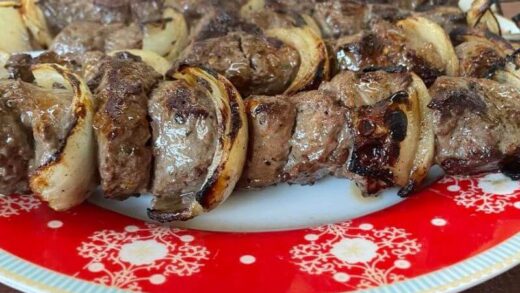HONEY SPONGE CAKE
For the genoise
6 large eggs, 1 cup + 2 tablespoons (215 g) granulated sugar, 1 ½ cups (190 g) all-purpose flour
For the syrup
½ cup (100 g) granulated sugar, 2 tablespoons Fernet (I’m using Fernet Hunter)
For the ganache
2 cups + 2 tablespoons (360 g) dark chocolate (finely chopped), 2 cups (480 ml) heavy cream
For the buttercream
¾ cup + 2 tablespoons (175 g) granulated sugar, 6 large egg yolks, 1 ½ cups + 1 teaspoons (350 g) unsalted butter (soft at room temperature), 2 tablespoons honey, 1 teaspoon vanilla extract, sea salt flake (to taste)
Adjust a rack to the middle of the oven, then pre-heat it to 350ºF (180ºC). Line two 8-inch (20-cm) cake pans with non-stick parchment paper, collaring them a few inches higher than the mold, as the genoise has a great deal of breath and expansion.
Put the eggs and sugar into the bowl of a stand mixer. Set it over a saucepan that’s filled with a few inches of barely simmering water. Heat, stirring slowly and often, until the mixture registers 120ºF (50ºC) on a thermometer. Remove, then set the bowl onto the mixer. Whisk, on medium-high speed, until pale, thick, and tripled in volume, about 5 minutes. Sift over the flour, then fold it in until just combined, being cautious not to deflate. Scrape into the prepared pans.
Bake for 20 to 22 minutes, until golden brown and springy to the touch. A skewer inserted into the middle should come out clean. Set aside to cool for 15 minutes on a wire rack, then invert, and cool completely.
Next, make the syrup. Put the sugar into a saucepan, along with ½ cup (120 ml) of water. Stir over medium heat until the granules have dissolved, then bring it to a boil. Remove, and stir in the Fernet. Transfer to a glass jar or container, and chill until cold.
When you’re ready to assemble, first, make the ganache. Put the chocolate into a heatproof bowl, and the cream into a saucepan. Bring the liquid to a simmer, then stream it all over the chocolate. Settle for a minute, then stir, slowly, until smooth. Stand until thick and spreadable before using on the cake, usually the time it takes to complete the following components.
For the buttercream, put the sugar into a saucepan, along with ¼ cup (60 ml) of water. Heat, over high, until it reaches 250ºF (121ºC) on a thermometer. Meanwhile, start whisking the yolks in the bowl of a stand mixer that’s set on medium speed. As soon as the syrup has come to temperature, stream it into the yolks. Raise the speed to high, and whisk until thick and glossy. All the steam will have escaped, and the bowl no longer hot to the touch. Switch out the whisk for the paddle. Beat in the butter, a tablespoon at a time, until it is all used up. A silky-smooth and aerated buttercream will have formed. Beat in the honey, followed by the vanilla, and lastly, the salt.
With a sharp serrated knife, slice each genoise horizontally in half. Brush the cut-sides with syrup. Scrape a few tablespoons of the buttercream into a piping bag fitted with a medium-round tip.
To assemble, set a bottom layer onto a serving plate. Spread over half of the buttercream, smoothing it out to the edges with an offset palette knife. Add on the second layer, cut-side facing down. Pipe the buttercream around the edges to dam, then fill it with enough ganache. Press on the third layer, and spread with the remaining buttercream. Top, with the last layer. Neaten the sides of the cake, and smooth out then fill any noticeable gaps. You want it to be as flush as possible. Scrape over the rest of the ganache, and slick it all over the cake, to coat.
Chill slightly, if needed, to make it easier to cut, then slice with a warm knife. It’s best eaten on the day of making, but will keep stored in an airtight container in the refrigerator for up to 2 days.
PEPPERBERRY CANELÉS
This recipe will make twenty-four canelés, and requires copper molds. If you don’t have enough (I don’t think I’ve ever come across anyone on a home-scale that has), you can bake in batches, keeping the residual batter cold, until needed.
For the batter
2 ¼ cups (540 ml) whole milk, ¼ cup (60 g) unsalted butter (cubed), ½ teaspoon ground Tasmanian pepperberries, 1 vanilla bean pod, ¾ cup + 2 tablespoons (110 g) all-purpose flour, 2 cups (240 g) confectioners’ sugar, ½ teaspoon salt, 2 large eggs, 3 large egg yolks, ¼ cup (60 ml) rum
For the white oil
¾ cup (75 g) clarified beeswax (chopped), ½ cup (115 g) unsalted butter (cubed)
Add the milk, butter, and pepperberry into a saucepan, and bring to just below the boil over medium heat (about 185ºF / 85ºC), stirring occasionally with a wooden spoon to evenly melt the cubes. Pour into a mixing bowl. Split open the vanilla bean, and scrape the seeds out from the spine. Add them into the liquid, and stir to combine. Set aside.
Next, in a large bowl, sift together the flour, confectioners’ sugar, and salt.
Lightly whisk together the eggs and yolks until homogenous. Pour into the infused milk, whisking gently, to incorporate. Stir through the rum. Set a fine-mesh sieve over the bowl with the dry ingredients, then stream through the liquids. Whisk to combine, and dissolve any lumps. The mixture should be thin and viscous, almost like crêpe batter. Again, pass through a sieve, but this time into a bowl or jug with a pouring spout. Cover, and leave undisturbed in the refrigerator for 48 hours.
Before you plan to bake, season your copper canelé molds. This recipe assumes that they’ve been used before, and is written for a quick-season, only. If they haven’t, Maurizio does a perfect job of explaining seasoning for first-use.
Adjust a rack to the middle of the oven, then pre-heat it to 370ºF (190ºC). Set the molds, open-side facing up, onto a baking sheet that’s lined with a few layers of aluminum foil. Position a wire rack over a second lined sheet.
Transfer the molds to the oven, and heat, for 2 minutes. Meanwhile, melt the beeswax and butter down in a medium saucepan. Working one at a time, immediately pour enough white oil into the warmed molds, filling them all the way to the top. Tip out and back into the pan, then invert onto the wire rack to drip out the excess. Cool, then transfer the molds back onto the original baking sheet. Freeze, until thoroughly chilled.
Remove the rested batter from the refrigerator, and give it a stir to awaken, without too much agitation. Pour into the molds, until it reaches about a third of an inch (1-cm) from the rim.
Bake for 20 minutes, then rotate the sheet, and lower the heat to 350ºF (180ºC). Continue to bake for another 30 minutes, then rotate again, and bake for another 10. The exterior of the canelés should be glossy and mahogany-dark, but not burnt, and the crowns, uniform. You can check their progress as they near the end, by quickly inverting and then returning to the oven, if needed, and adjusting your time as necessary as some will bake faster than others. Remove, and lift off and onto a wire rack. Invert immediately, using tongs or gloves, as the copper will retain its burning heat.
Cool the canelés for at least an hour, before eating. The shells will protectively harden and crisp, and the interior settle, into a custard-like web.
#recipes #book #Butter #Brioche

![[Meat Free January] Grilled Cheese from Grill My Cheese](https://foodsaregood.com/wp-content/uploads/2023/11/Meat-Free-January-Grilled-Cheese-from-Grill-My-Cheese-520x293.jpg)


